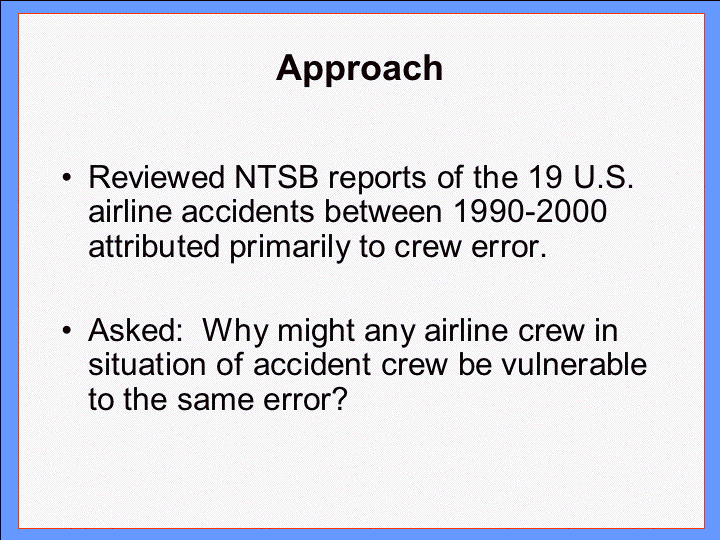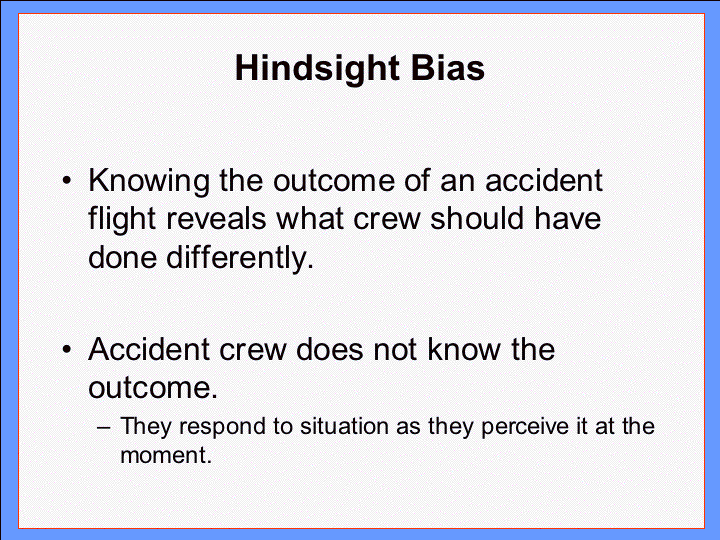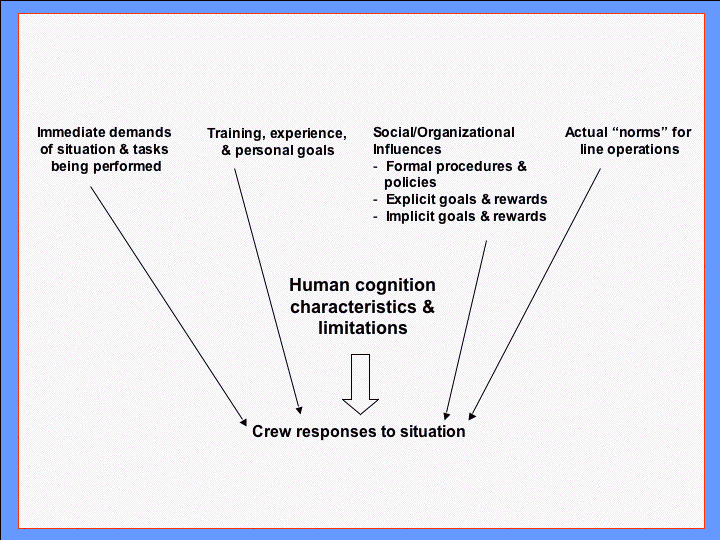A
Truism
about
Accidents
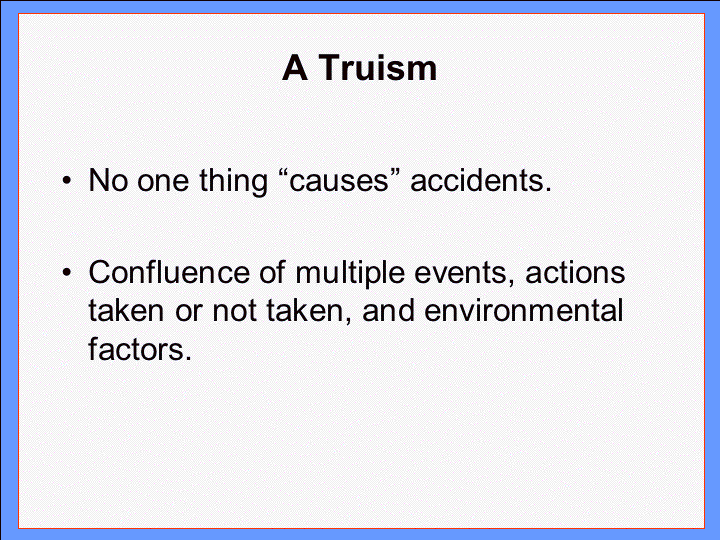
One
thing
is
immediately
obvious
about
almost
all
human
factors
accidents
we
have
looked
at
over
the
years:
No
one
thing
“caused”
the
accident;
rather
accidents
typically
occur
from
the
confluence
of
multiple
events,
actions
taken
or
not
taken
by
individuals,
and
the
environment
in
which
those
individuals
operate.
Although
this
truism
is
recognized
by
the
industry
we
need
to
look
more
deeply
at
the
implications
of
this
fact.
Confluence
of
Factors
in
a CFIT
Accident
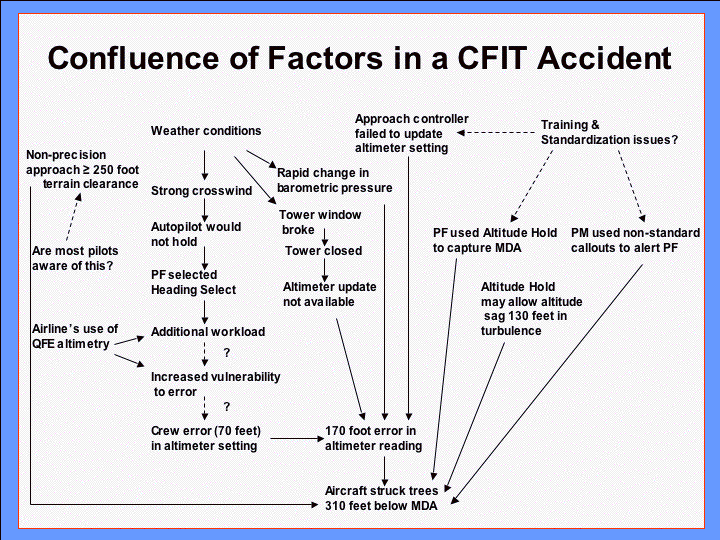
This
confluence
is
illustrated
in
this
slide
of
factors
in
a CFIT
accident
in
which
a MD-83
struck
trees
310
feet
below
MDA
on
a non-precision
approach
in
1995.
I wonder
if
all
pilots
are
even
aware
that
non-precision
approaches
in
the
U.S.
can
give
as
little
as
250
feet
of
terrain
clearance?
Weather
played
a central
role
in
this
accident
in
several
ways:
barometric
pressure
was
changing
rapidly,
there
was
a strong
crosswind,
the
tower
window
broke,
causing
the
tower
to
close.
The
approach
controller
failed
to
update
the
altimeter
setting
before
switching
frequency
and
the
crew
did
not
request
an
update.
At
the
time
the
airline
used
QFE
altimetry.
Workload
was
high,
in
part
because
of
the
crosswind
and
the
PF’s
use
of
Heading
Select.
The
crew
slightly
mis-set
the
altimeters,
causing
a 70
foot
error;
this
plus
the
rapid
change
in
barometric
pressure
caused
the
aircraft
to
fly
170
feet
lower
than
the
altimeters
indicated.
The
pilot
flying
(PF)
used
Altitude
Hold
to
capture
MDA,
however
in
turbulence
Altitude
Hold
can
allow
the
aircraft
to
sag
as
much
as
130
feet
below
the
target
altitude.
The
pilot
monitoring
(PM)
called
out
that
they
were
passing
through
MDA,
using
somewhat
non-standard
phraseology
and
the
aircraft
struck
trees
310
feet
below
minimum
descent
altitude
(MDA).
Fortunately,
although
the
aircraft
was
heavily
damaged,
no
one
was
severely
injured.
My
point
in
going
through
this
slide
is
not
to
talk
about
the
details
of
this
specific
accident.
None
of
the
factors
in
this
accident
were
all
that
extraordinary;
it
was
the
particular
way
that
all
of
these
factors
happened
to
combine
that
produced
the
accident.
It’s
popular
these
days
to
talk
about
the
“accident
chain”,
but
clearly
this
is
not
a single
chain,
it
is
a confluence
of
many
factors
operating
in
parallel
and
converging.
The
occurrence
and
combination
of
all
these
factors
in
a single
flight
is
to
large
degree
a matter
of
chance,
and
there
is
the
great
challenge.
Chance
Combination
of
Contributing
Factors
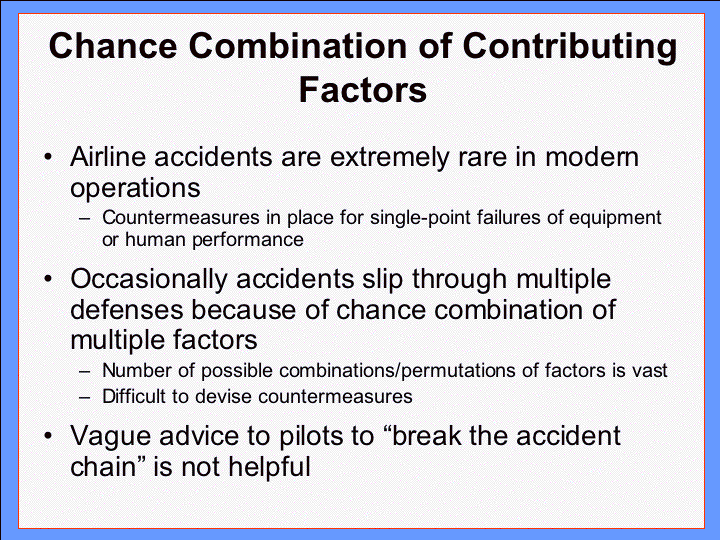
In
our
modern
airspace
system
accidents
are
very
rare
events
because
the
industry
has
developed
ways
of
preventing
single-point
failures
in
equipment
or
human
performance
from
causing
accidents.
The
few
accidents
that
slip
through
all
the
defenses
occur
because
of
the
largely
random
combination
of
many
factors.
This
random
aspect
makes
it
very
difficult
to
develop
countermeasures
to
prevent
future
accidents
because
the
number
of
combinations
and
permutations
of
factors
that
might
occur
in
a flight
are
virtually
infinite.
And
it
is
very
scary—none
of
us
like
to
feel
we
are
operating
in
a system
that
we
cannot
completely
control.
Until
we
deal
with
this
reality
we
will
not
make
much
progress
in
improving
aviation
safety.
It
is
commonplace
to
propose
that
we
teach
pilots
to
avoid
accidents
by
“breaking
the
accident
chain”
but
it
is
not
at
all
clear
how
pilots
can
recognize
in
the
midst
of
a demanding
flight
the
many
different
ways
multiple
factors
can
combine
by
chance
to
lead
to
an
accident.
6
Overlapping
Clusters
of
Error
Patterns
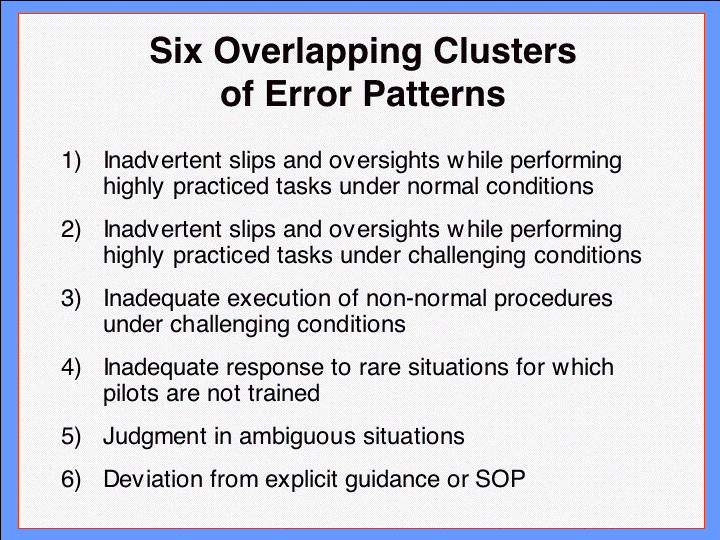
In
our
study
we
took
the
crew
errors
identified
by
the
NTSB
at
face
value—in
hindsight
it
is
clear
some
of
the
actions
the
crews
took
were
not
the
right
things
to
do.
However
by
the
end
of
this
talk
I hope
you
will
be
asking
questions
about
how
we
should
think
about
these
errors
and
what
they
represent.
We
found
the
errors
in
the
19
accidents
to
cluster
roughly
into
six
groups,
with
some
overlap
among
the
groups.
These
clusters
are
defined
as
much
by
the
situations
confronting
the
pilots
as
by
the
form
of
error.
Inadvertent
Slips/Oversights
in
Practiced
Tasks
Under
Normal
Conditions

The
first
group
consists
of
inadvertent
slips
and
oversights
while
performing
highly
practiced
tasks
under
normal
conditions.
Examples
are
overlooking
a checklist
item,
remembering
an
altimeter
setting
incorrectly,
and
slightly
misjudging
the
landing
flare.
These
errors
are
very
much
the
same
as
the
errors
pilots
themselves
report
making
to
ASRS
and
ASAP
programs.
From
a cognitive
perspective
occasional
errors
made
by
experts
are
an
inevitable
consequence
of
the
way
the
brain
is
wired,
the
incomplete
information
available
at
the
time
to
the
expert,
and
the
competing
demands
of
tasks.
No
pilot
is
immune
to
these
errors,
so
in
many
cases
the
difference
between
an
accident
flight
and
a routine
non-accident
flight
is
not
the
presence
of
errors
but
the
happenstance
combination
of
the
errors
with
several
other
factors.
Inadvertent
Slips/Oversights
in
Practiced
Tasks
Under
Challenging
Conditions

The
probability
of
making
these
inadvertent
slips
and
oversights
goes
up
with
workload,
time
pressure,
fatigue,
and
stress.
In
some
accidents
we
noted
a snowball
effect
in
which
decisions
or
actions
at
one
stage
of
the
flight
increased
the
crew’s
vulnerability
to
making
errors
later.
For
example,
a crew
that
continued
a highly
questionable
approach
in
the
vicinity
of
a thunderstorm
put
themselves
in
a high
workload
situation
that
may
have
contributed
to
their
forgetting
to
arm
the
spoilers.
Inadequate
Execution
of
Non-Normal
Procedures
Under
Challenging
Conditions
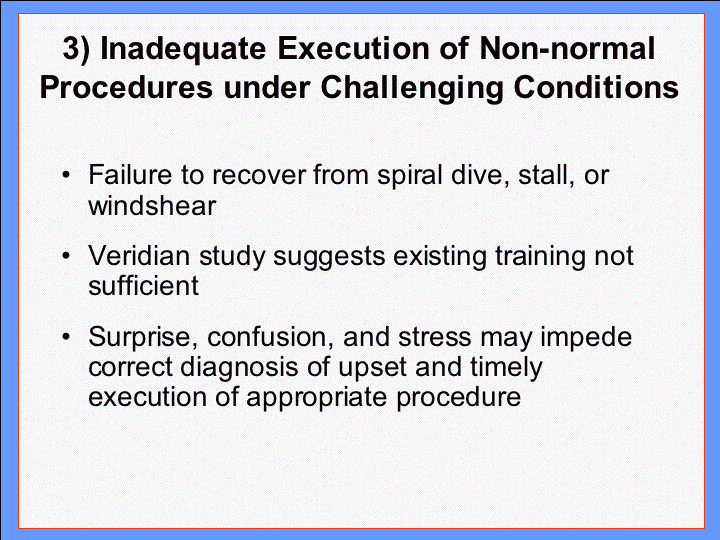
Four
of
these
19
accidents
involved
inadequate
execution
of
non-normal
procedures
under
challenging
conditions.
These
included
imperfect
execution
of
procedures
for
recovering
from
a spiral
dive,
from
a stall,
and
from
windshear.
These
days
pilots
are
trained
to
recover
from
these
situations,
but
a recent
study
by
Veridian
Corporation
revealed
that
even
with
upset
training
many
pilots
have
trouble
executing
recovery
procedures
adequately.
We
suspect
that
one
shortcoming
of
existing
upset
recovery
training
is
that
in
the
training
pilots
are
expecting
the
upset
and
typically
they
know
which
upset
they
are
about
to
encounter.
But
in
the
real
world
of
surprise,
confusion,
and
stress
pilots
may
have
trouble
identifying
the
nature
of
the
upset
and
selecting
the
correct
recovery
procedure.
Inadequate
Response
to
Rare
Situations
for
which
Pilots
are
not
Trained
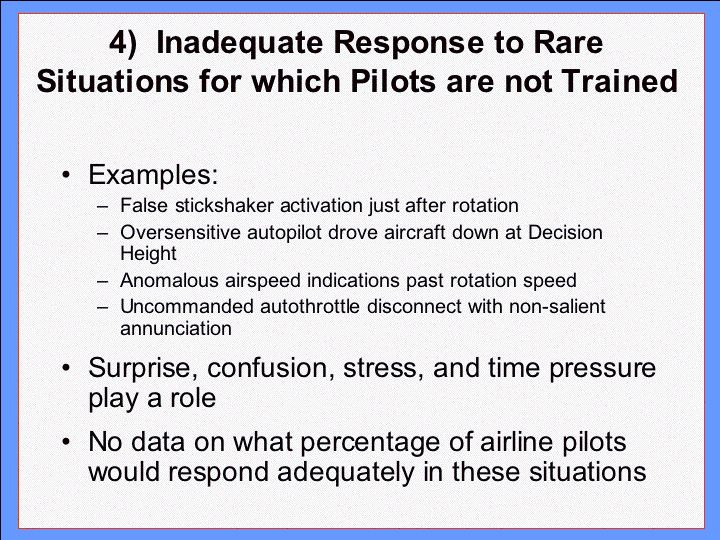
The
fourth
cluster
involved
inadequate
response
to
rare
situations
for
which
pilots
are
not
trained.
These
situations
included
a false
stickshaker
activation
just
after
rotation,
an
oversensitive
autopilot
that
drove
the
aircraft
toward
the
ground
near
Decision
Height,
anomalous
indications
from
airspeed
indicators
that
did
not
become
apparent
until
the
aircraft
was
past
rotation
speed,
and
an
uncommanded
autothrottle
disconnect
whose
annunciation
was
not
at
all
salient.
Here
too
surprise,
confusion,
stress,
and
time
pressure
undoubtedly
play
a role.
No
data
exist
on
what
percentage
of
airline
pilots
would
respond
quickly
and
correctly
to
these
situations,
but
we
suspect
that
performance
is
unlikely
to
be
reliable
under
these
conditions.
Judgement
and
Decision-Making
in
Ambiguous
Situations

The
fifth
cluster
of
errors
involved
judgment
in
ambiguous
situations
that
hindsight
proves
wrong.
An
example
of
judgment
in
ambiguous
situations
is
continuing
an
approach
toward
an
airport
in
the
vicinity
of
thunderstorms.
No
algorithm
exists
for
crews
to
calculate
exactly
how
far
they
may
continue
an
approach
in
the
vicinity
of
thunderstorms
before
it
should
be
abandoned.
Company
guidance
is
generally
expressed
in
rather
general
terms,
and
the
crew
must
make
this
decision
by
integrating
fragmentary
and
incomplete
information
from
various
sources,
and
playing
it
by
ear.
When
an
aircraft
crashes
while
attempting
an
approach
under
these
conditions,
the
crew
is
typically
found
to
be
at
fault.
Yet
there
are
reasons
to
suspect
that
the
decision-making
of
the
accident
crews
was
similar
to
that
of
crews
who
were
more
fortunate.
A Lincoln
Lab
study
of
radar
data
at
Dallas
Fort
Worth
revealed
that
when
thunderstorms
are
near
the
approach
path
it
is
not
all
that
uncommon
for
airliners
to
penetrate
the
cells.
And
in
the
investigation
of
windshear
accidents
it
is
not
uncommon
to
find
that
another
aircraft
landed
or
took
off
a minute
or
two
ahead
of
the
accident
aircraft
without
difficulty.
Both
crews
had
the
same
information
and
made
the
same
decision,
but
rapidly
fluctuating
conditions
allowed
one
to
land
without
difficulty
and
caused
the
other
to
crash.
In
these
ambiguous
situations,
instead
of
blaming
the
accident
crew
for
poor
judgment,
maybe
we
should
focus
more
on
asking
what
are
the
industry
norms
for
operating
in
these
situations.
Does
the
industry
provide
sufficient
guidance
for
pilots
to
balance
competing
goals?
Do
we
have
explicit
policies
that
sound
conservative
but
implicitly
tolerate
or
even
encourage
less
conservative
behavior
as
long
as
crews
get
by
with
it?
Deviation
from
Explicit
Guidance
or
SOP

The
last
cluster
involves
deviation
from
explicit
guidance
or
standard
operating
procedures.
An
example
is
attempting
to
land
from
an
unstabilized
approach
resulting
from
a slam-dunk
clearance.
If
the
company
has
explicit
stabilized
approach
criteria,
these
errors
may
seem
simply
to
be
willful
violations.
But
even
here
the
situation
may
not
be
as
simple
as
it
seems.
Does
the
company
publish
and
train
the
stabilized
approach
criteria
as
an
absolute
bottom
line
or
merely
as
guidance?
What
are
the
norms
for
what
pilots
actually
do
in
the
company
and
in
the
industry?
We
have
heard
some
pilots,
even
some
check
pilots,
express
the
view
that
being
unstabilized
at
500
feet
is
not
a problem
as
long
as
the
flying
pilot
is
correcting
and
gets
the
aircraft
back
within
normal
parameters
by
touchdown.
What
these
pilots
may
not
grasp
is
that
correcting
an
unstabilized
approach
imposes
so
much
workload
that
the
flying
pilot
does
not
have
enough
mental
capacity
left
over
to
reliably
assess
whether
he
is
going
to
be
able
to
get
everything
back
to
normal
by
touchdown.
Cross-Cutting
Factors
Contributing
to
Crew
Errors
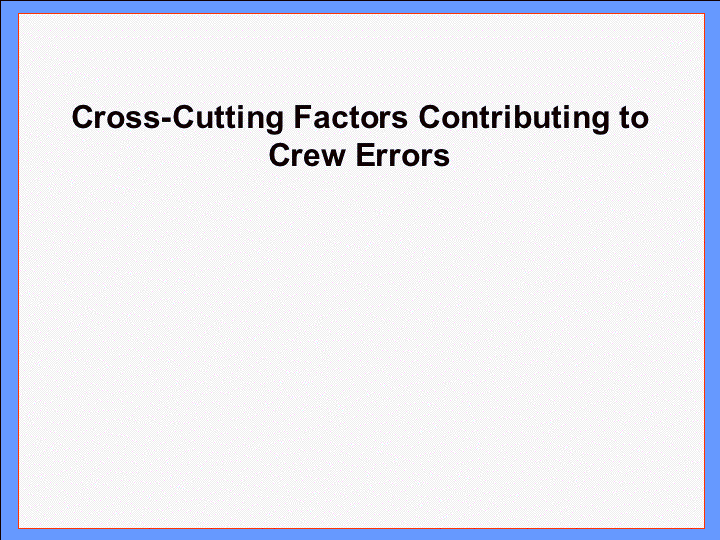
A
range
of
cross-cutting
factors
in
these
accidents
contributed
to
the
vulnerability
of
pilots
to
making
these
sorts
of
errors.
Situations
Requiring
Rapid
Response
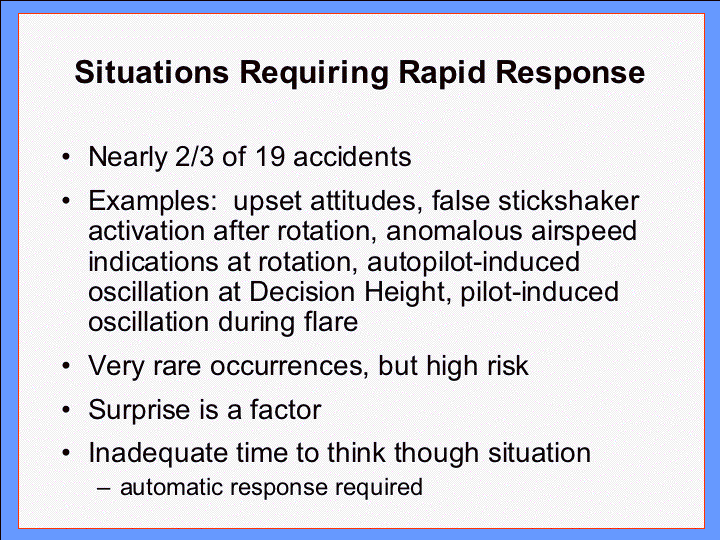
To
our
great
surprise,
nearly
2/3
of
these
accidents
involved
situations
in
which
the
crew
had
only
a matter
of
seconds
to
choose
and
execute
the
appropriate
response.
Examples
include
upset
attitudes,
false
stickshaker
activation
just
after
rotation,
anomalous
airspeed
indications
at
rotation,
pilot
induced
oscillation
during
flare,
and
autopilot
induced
oscillation
at
decision
height.
We
were
surprised
because
most
threatening
situations
encountered
in
airline
operations
allow
the
crew
time
to
think
through
what
to
do,
and
in
these
situations
it
is
important
to
avoid
rushing.
We
conclude
that
these
19
accidents
included
a disproportionately
high
number
of
situations
requiring
very
rapid
response
because,
although
these
situations
are
quite
rare,
when
they
do
occur
it
is
extremely
difficult
for
crews
to
overcome
their
surprise,
assess
the
situation,
and
quickly
execute
the
appropriate
response.
Human
cognitive
processes
simply
do
not
allow
pilots
to
reliably
assess
novel
situations
quickly.
Challenges
of
Managing
Concurrent
Tasks
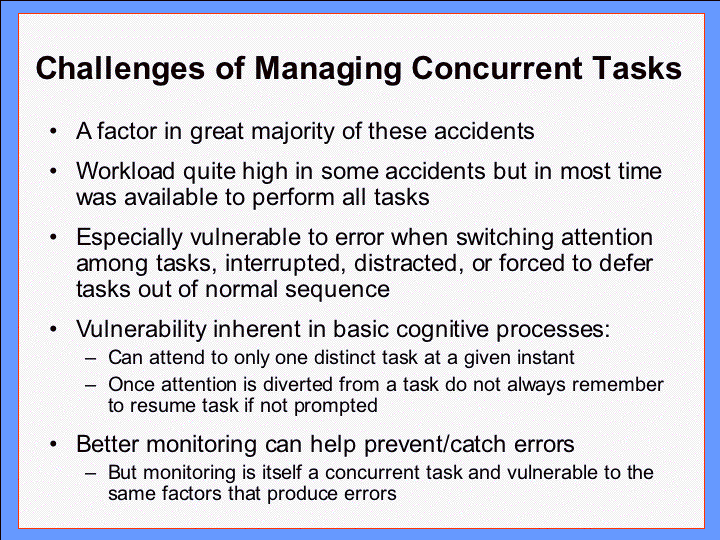
The
challenge
of
managing
multiple
tasks
concurrently
showed
up
in
the
great
majority
of
these
accidents.
In
some
cases
workload
was
quite
high
in
the
final
stages
of
the
accident
sequence.
In
other
cases
adequate
time
was
available
to
perform
all
required
tasks,
however
the
inherent
difficulty
of
reliably
switching
attention
back
and
forth
among
concurrent
tasks
may
have
hampered
performance.
More
effective
monitoring
might
have
helped
some
of
these
accident
crews
prevent
or
detect
many
of
the
errors
made;
unfortunately
in
many
situations
monitoring
must
itself
be
performed
as
a concurrent
task
and
is
itself
subject
to
the
same
fragility
of
becoming
preoccupied
with
the
task
at
hand
and
forgetting
to
switch
attention
to
monitor
other
tasks.
Equipment
Failures
and
Design
Flaws
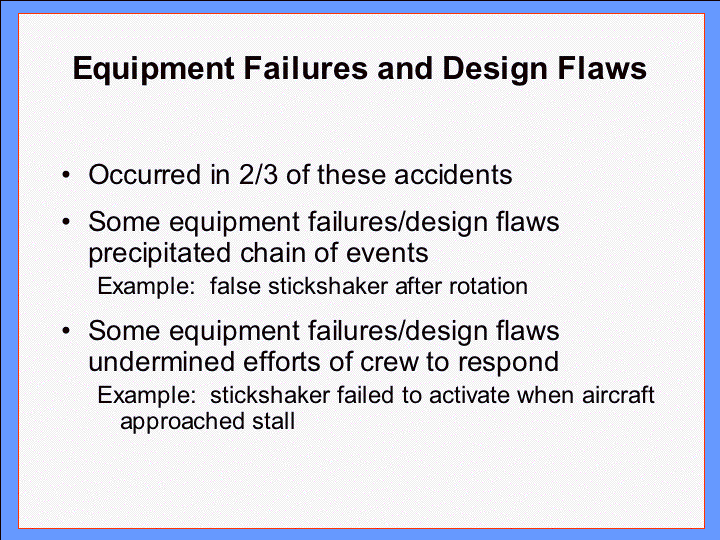
Equipment
failures
and
design
flaws
appeared
in
about
2/3
of
these
accidents.
In
some
cases
a design
flaw
or
equipment
failure
precipitated
the
chain
of
events
leading
to
the
accident—I
already
mentioned
a false
stickshaker
warning
that
occurred
right
after
rotation.
In
other
accidents
a flaw
or
failure
undermined
the
efforts
of
the
crew
to
manage
their
situation—for
example
in
several
accidents
the
stickshaker
failed
to
activate
when
it
should
have,
depriving
the
crew
of
critical
information.
Stress
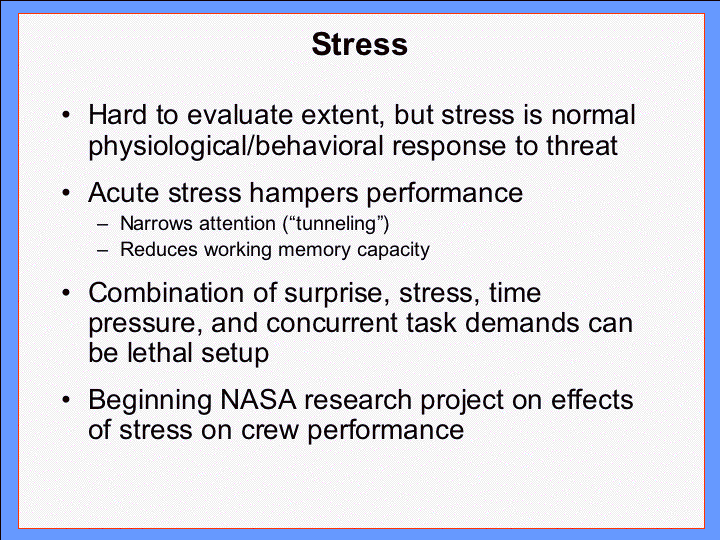
Although
we
cannot
be
sure
of
the
extent,
we
suspect
that
stress
played
a role
in
many
of
these
accidents
by
interfering
with
the
crews’
cognitive
processes.
Stress
hampers
skilled
performance
by
narrowing
attention
and
reducing
working
memory
capacity
required
to
execute
even
highly
practiced
tasks.
In
particular,
the
combination
of
stress
and
surprise
with
requirements
to
respond
rapidly
and
to
manage
several
tasks
concurrently,
as
occurred
in
several
of
these
accidents,
is
a lethal
setup.
Shortcomings
in
Training
and/or
Guidance
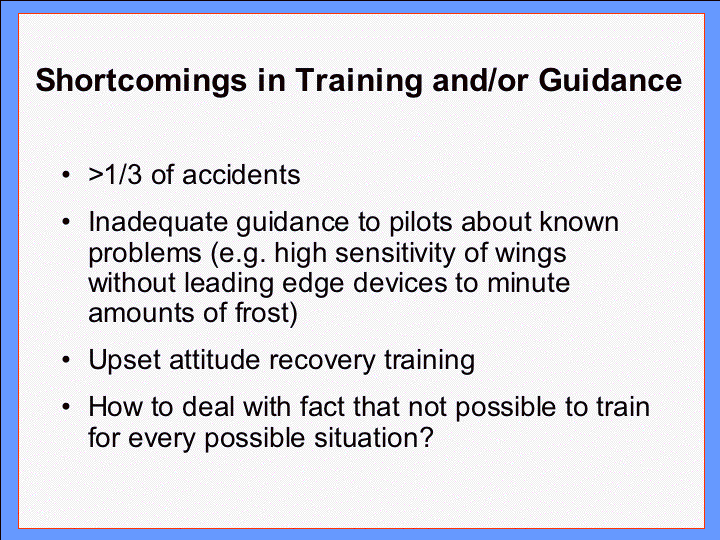
Shortcoming
in
training
and/or
guidance
appeared
in
more
than
a third
of
these
accidents.
In
some
cases
pilots
were
not
provided
adequate
guidance
about
problems
known
to
exist
by
some
segments
of
the
industry.
Three
of
the
accidents
involved
upset
attitudes—I’ve
already
suggested
that
we
need
to
find
ways
to
develop
more
realistic
scenarios
with
which
to
present
upset
attitude
recovery
training.
But
beyond
this,
we
have
to
find
a way
to
deal
with
the
fact
that
it
is
simply
not
possible
to
train
for
every
possible
situation—which
raises
the
question
of
how
best
to
provide
generic
training
and
procedures
that
will
work
in
a broad
range
of
unanticipated
situations.
Plan
Continuation
Bias
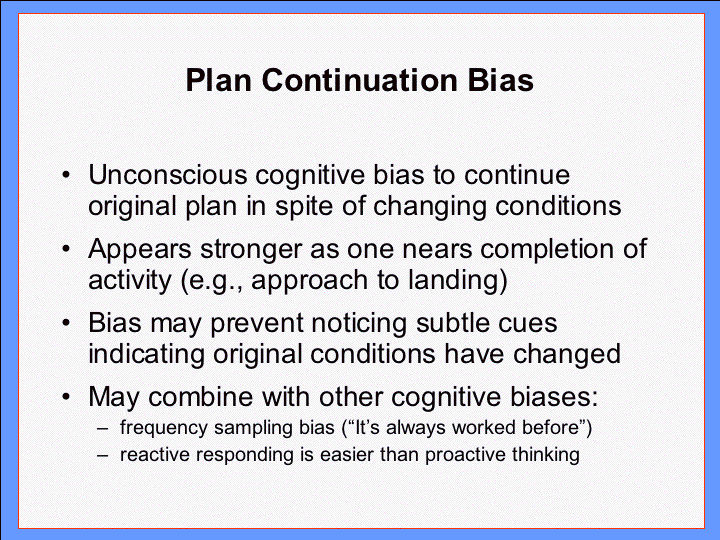
Plan
continuation
bias
may
impede
crews’
ability
to
recognize
that
they
need
to
change
their
course
of
action.
This
is
a powerful
but
unconscious
cognitive
bias
to
continue
the
original
or
habitual
course
of
action.
This
bias
may
be
especially
strong
during
the
approach
phase,
when
only
a few
more
steps
are
required
to
complete
the
original
plan,
and
it
may
operate
by
preventing
pilots
from
noticing
subtle
cues
indicating
that
the
original
conditions
have
changed.
Social/Organizational
Issues
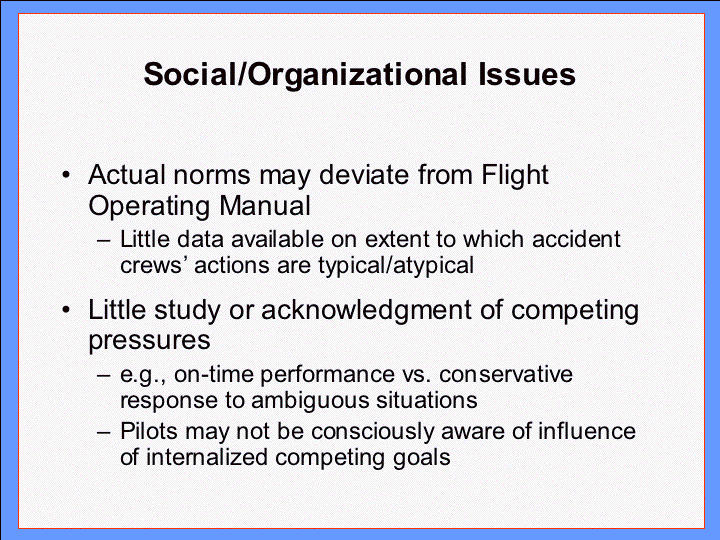
Social
and
organizational
issues
have
a pervasive
influence
but
have
not
been
studied
in
depth.
For
example,
little
data
is
available
to
accident
investigators
on
the
extent
to
which
the
accident
crews’
actions
were
typical
or
atypical
in
the
situation
they
faced.
Also,
pilots
may
not
be
consciously
aware
of
the
influence
of
internalized
competing
goals,
for
example
the
trade-offs
between
on-time
performance
and
conservative
response
to
ambiguous
situations.
Little
research
has
been
conducted
on
this
aspect.
Countermeasures?
No
Easy
Solutions
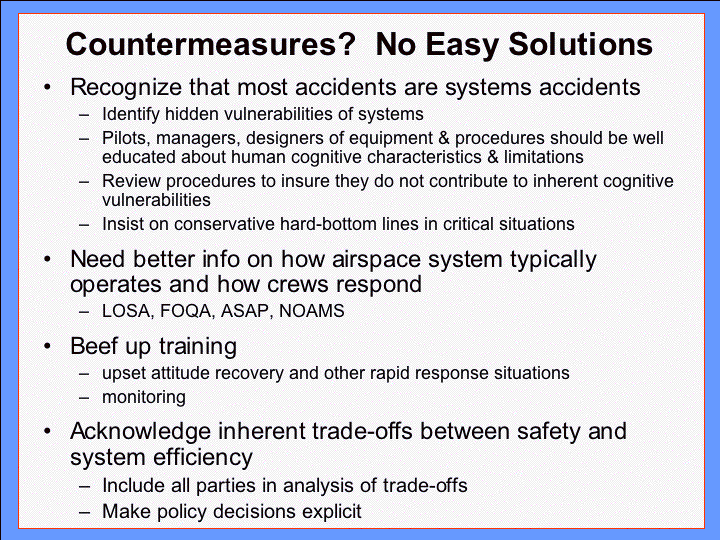
It
will
not
be
easy
to
reduce
vulnerability
to
the
kinds
of
accidents
I’ve
been
describing.
The
U.S.
airline
system
already
operates
at
a very
high
level
of
safety;
consequently
every
accident
that
occurs
in
this
system
is
a unique
combination
of
events,
circumstances,
and
errors
that
slipped
through
the
system
of
existing
defenses.
But
I will
make
a few
high-level
suggestions.
We
can
start
by
recognizing
that
most
accidents
are
systems
accidents
and
by
shifting
our
focus
from
blaming
pilots
for
errors
to
identifying
vulnerabilities
of
complex
systems
and
developing
countermeasures.
Pilots,
managers,
designers
of
equipment,
and
designers
of
operating
procedures
should
be
well
educated
about
human
cognitive
characteristics
and
limitations;
the
design
of
equipment,
procedures,
and
training
should
be
based
on
that
knowledge.
We
can
never
completely
eliminate
pilot
error,
but
we
can
reduce
the
frequency
of
errors
and
we
can
give
pilots
tools
to
catch
errors
and
mitigate
their
consequences.
Countermeasures?
No
Easy
Solutions
(Cont'd)
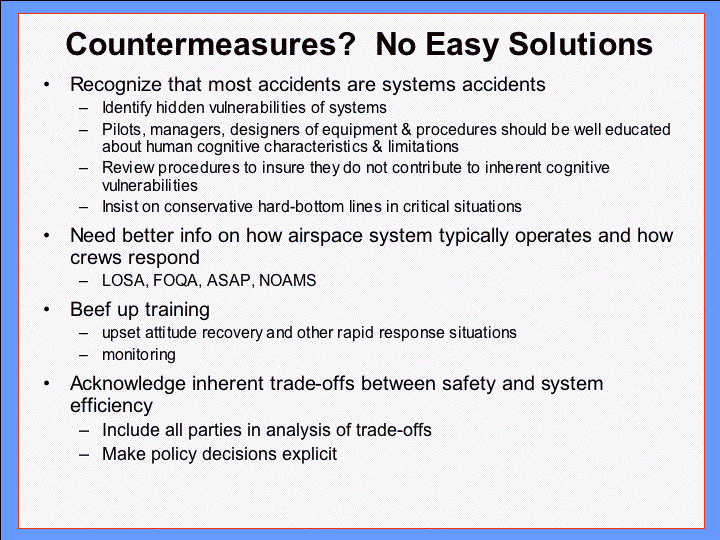
Plan
continuation
bias,
task
saturation,
and
inadvertent
omission
of
procedural
steps
are
examples
of
inherent
cognitive
vulnerabilities.
We
should
systematically
review
normal
and
non-normal
operating
procedures
to
insure
they
are
consistent
with
human
abilities
to
manage
competing
task
demands,
time
pressure,
and
stress.
Conservative,
hard
bottom
lines,
such
as
stabilized
approach
criteria
are
important
defenses
against
the
consequences
of
error,
but
to
be
effective
these
bottom
lines
must
be
practiced
consistently
and
vigorously,
and
they
must
take
precedence
over
concern
with
time
and
fuel
costs.
Crew
decision-making
is
hampered
by
ambiguous,
incomplete,
and
conflicting
information,
so
we
should
provide
crews
with
better
information.
Exactly
where
is
the
dangerous
convective
weather
in
real
time?
What
is
the
precise
nature
of
the
aircraft
system
failure
that
is
causing
warning
lights
to
illuminate
from
three
different
subsystems?
Countermeasures?
No
Easy
Solutions
(Cont'd)
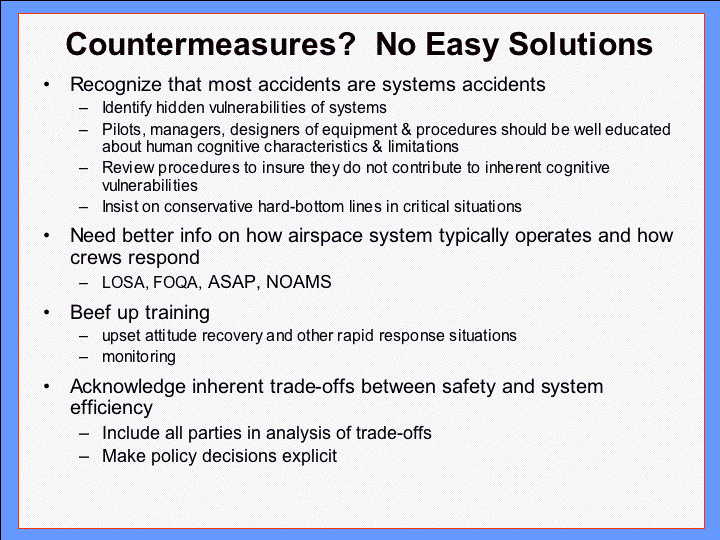
We
need
much
better
information
about
how
the
airspace
system
operates
and
how
crews
typically
respond.
For
example,
how
often
and
at
what
airports
do
controllers
issue
slam-dunk
clearances
and
last
minute
runway
changes?
How
do
pilots
typically
deal
with
these
challenges
and
how
close
do
they
come
to
the
edge
of
the
safety
envelope?
How
close
do
flights
come
to
storm
cells
during
arrival
and
departure,
and
is
the
variation
among
flights
due
to
differences
in
crew
judgment
or
to
chance?
Programs
such
as
LOSA,
FOQA,
ASAP,
and
NOAMS
can
help
generate
answers
to
these
questions
but
we
have
yet
to
fully
exploit
the
potential
of
these
programs.
We
could
beef
up
our
training
for
upset
recovery
and
for
other
situations
requiring
very
rapid
response.
And
we
should
develop
specific
techniques
to
train
monitoring.
Finally,
we
should
explicitly
acknowledge
that
there
are
inherent
trade-offs
between
the
level
of
safety
and
system
efficiency.
These
trade-offs
show
up
in
many
ways,
for
example,
in
decisions
in
how
much
training
to
provide.
Cost-benefit
trade-offs
are
inherently
policy
issues.
Those
issues
should
be
analyzed
explicitly,
and
all
stakeholders
should
participate.
My
point
is
that
more
can
be
done
to
protect
safety
by
explicitly
analyzing
these
trade-offs
than
by
naively
expecting
crews
to
perform
perfectly.
That
is
why
I called
this
talk
The
Limits
of
Expertise.
If
you
would
like
to
comment
on
this
article,
please
click
here
.
We
invite
your
thoughtful
feedback
and
comments,
and
we
encourage
you
to
submit
opinions,
anecdotes,
personal
experiences,
and
ideas
that
relate
to
this
article.
The
author
of
each
article
will
compile
a
summary
of
the
responses
received
and
post
it
before
the
next
hot
topic
is
presented.
